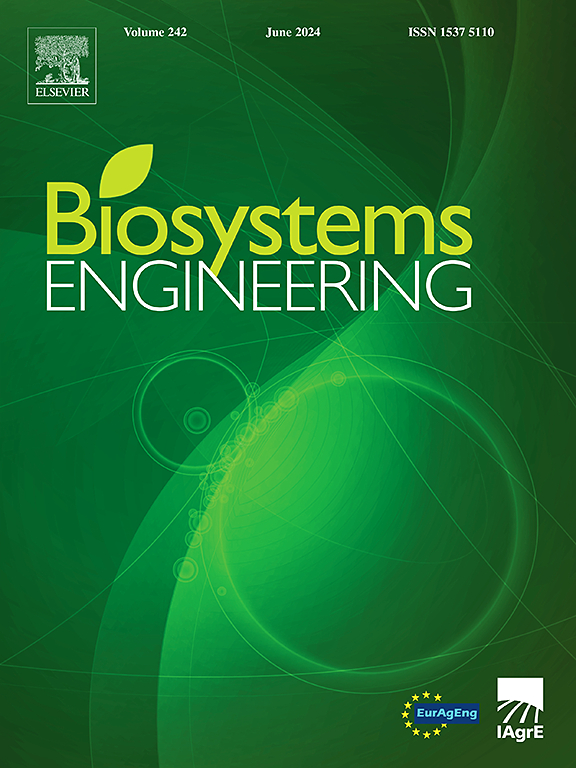利用树桩接近和机器学习模拟机器引起的森林土壤变形
IF 5.3
1区 农林科学
Q1 AGRICULTURAL ENGINEERING
引用次数: 0
摘要
土壤变形是可持续木材采伐的关键挑战,特别是在承载力低的环境中。在机械化林业中,这个问题在泥炭地尤其明显,那里的车辙是由土壤位移和柔软的有机基质内的根系剪切引起的。虽然已知树根可以加固土壤,但残根系统在减轻车辙形成方面的具体作用仍未得到充分探索。本研究使用基于无人机(UAV)的数字地形模型(dtm)、人工现场测量、空间建模和机器学习技术来研究树桩存在对车辙深度的影响。首先将无人机得出的车辙深度估计值与人工数据进行比较,发现更深的车辙深度估计值略低,特别是在弯曲的轨迹上,平均误差为3厘米。统计分析证实,累积残桩影响显著降低了车辙深度,在直道中影响小到中等,在弯道中影响中等,在弯道中影响较大,在弯道中影响较大。机器学习模型的预测精度很高(R2 = 0.69-0.85),识别出树桩相关变量和土壤剪切模量是车辙形成的关键预测因子。这些发现强调了将树桩根加固纳入森林规划以优化机器路径选择和减少土壤干扰的重要性。未来的研究应完善特定树种的加固模型,探索先进的根系测绘技术,如探地雷达(GPR),以加强可持续林业的决策支持工具。本研究提出了一种基于空间信息的方法来评估泥炭地土壤树桩-根系对车辙形成的影响。通过集成无人机测绘和机器学习,该研究能够预测识别低影响区域,减少现场干扰并支持气候智能型林业。这些发现为优化滑轨布局、提高作业效率、减少土壤干扰和场地破坏提供了一个实用的起点和潜在的工具。该方法支持泥炭地保护的循证决策,帮助森林作业与更广泛的环境和气候目标保持一致。本文章由计算机程序翻译,如有差异,请以英文原文为准。
Modelling machine-induced soil deformation in forest soils using stump proximity and machine learning
Soil deformation is a key challenge in sustainable timber harvesting, particularly in environments with low bearing capacity. In mechanised forestry, this issue is especially pronounced in peatlands, where rutting arises from soil displacement and root shearing within the soft, organic substrate. While tree roots are known to reinforce soil, the specific role of stump-root systems in mitigating rut formation remains underexplored. This study examines the influence of stump presence on rut depth using Unmanned Aerial Vehicle (UAV) based digital terrain models (DTMs), manual field measurements, spatial modelling, and machine learning techniques. UAV-derived rut depth estimates were first compared with manual data, revealing slightly lower values in deeper ruts, particularly in curved trails, with mean discrepancies of 3 cm. Statistical analysis confirmed that cumulative stump influence significantly reduced rut depth, with a small to medium effect in straight trails ( = 0.04–0.20) and a moderate to large effect in curved trails ( = 0.02–0.32). Machine learning models achieved high predictive accuracy ( = 0.69–0.85), identifying stump-related variables and soil shear modulus as key predictors of rut formation. These findings emphasise the importance of incorporating stump-root reinforcement into forest planning to optimise machine path selection and minimise soil disturbance. Future research should refine species-specific reinforcement models and explore advanced root mapping techniques, such as ground-penetrating radar (GPR), to strengthen decision-support tools for sustainable forestry.
Science4Impact statement (S4IS)
This study presents a spatially informed methodology to evaluate the influence of tree stump-root systems on rut formation in peatland soils. By integrating UAV mapping and machine learning, this study enables the predictive identification of low-impact areas, reducing site disturbance and supporting climate-smart forestry. These findings offer a practical starting point and a potential tool for optimising skid trail layout, improving operational efficiency, and minimising soil disturbance and site damage. The approach supports evidence-based decision-making in peatland conservation, helping align forest operations with broader environmental and climate goals.
求助全文
通过发布文献求助,成功后即可免费获取论文全文。
去求助
来源期刊

Biosystems Engineering
农林科学-农业工程
CiteScore
10.60
自引率
7.80%
发文量
239
审稿时长
53 days
期刊介绍:
Biosystems Engineering publishes research in engineering and the physical sciences that represent advances in understanding or modelling of the performance of biological systems for sustainable developments in land use and the environment, agriculture and amenity, bioproduction processes and the food chain. The subject matter of the journal reflects the wide range and interdisciplinary nature of research in engineering for biological systems.
 求助内容:
求助内容: 应助结果提醒方式:
应助结果提醒方式:


